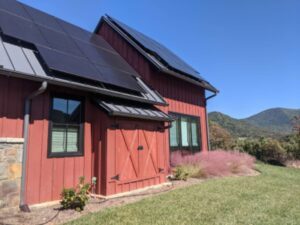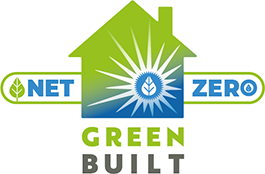Certified Green Built Homes are just better for you and the environment. Homes that are allowed to earn this label are verified (via science-backed inspection and testing protocols) to contain features, and be built using building practices, that reduce the home’s energy and water use, improve indoor air quality, protect the local environment, and reduce waste and carbon impact.
To earn Green Built Homes certification, a list of minimum pre-requisites must be met, and then many additional, optional features and practices must be selected in order to earn enough points. The more points, the higher the certification level, with levels such as Certified, Silver, Gold, and Platinum available.
But the Green Built Homes program contains several other designations as well, open to any home that can achieve at least a Certified level in our program. The next series of blogs will discuss these, and the first of these is designation as a Net Zero Energy home.
Green Built Homes awards the designation of Net Zero Energy to any Green Built Home achieving a HERS index of 15 or less, which typically requires a combination of advanced energy efficient features, and rooftop or ground mounted solar.
What is Net Zero Energy?
This term has been around in the green building world for decades, but has gained prominence in the last decade of surging interest in green building, and still deserves some defining. In essence, a net zero energy home is a home that is powered by renewable energy rather than fossil fuel energy, but in practicality, this can look a few different ways.
In ideal terms, a totally zero energy home would be a home that uses zero energy from the grid or a fossil fuel. This is technologically possible, when technologies like solar or even wind and micro-hydro are paired with a highly energy efficient design to begin with, and are paired with batteries to store the energy produced by those renewable energy systems for when the sun isn’t shining or the wind isn’t blowing. There are such homes all around the country and world, and have been for decades, but they have been somewhat less than mainstream due to the costs and design challenges specifically of the batteries.
But there are also many, many homes that use solar while still maintain a connection to the grid for electricity. This has become the most popular and fastest-growing way to deploy renewable energy into the marketplace—dramatically reducing the dependence of any individual home on the grid, dramatically reducing home energy use, and helping grow and bring the cost down of solar especially.
Those homes may still use energy from other sources at some times. They don’t have batteries, so they’ll pull grid energy when the sun isn’t shining. Sometimes they still use a fossil fuel for heating, water heating, or cooking. But they make up for it as well, by sending excess energy that they produce back out to the grid when they aren’t able to use it, and the nature of solar array design usually lends itself to this. Most utilities in North Carolina pay homeowners for this excess energy, so in effect the “net” energy bills of a home could be at or near zero, even if the home doesn’t always use the exact power it produces.

This is a deeply practical way to live, as batteries are expensive and finicky, and like it or not, we are all interconnected. Distributed rooftop solar is a widely recognized way to increase the greenness of the grid overall.
How is this measured? Typically, using the HERS Index. Energy efficiency measures reduce a home’s HERS score, and energy efficinecy is critical to a good net zero energy home, because reducing energy is more effective overall than generating it. But once you get to a certain level of energy efficiency (through measures like insulation, air-tightness, passive building design, efficient appliances, heating and cooling systems, and water heating systems), it becomes challenging to make the building more efficient and reduce the HERS score further. At that point solar starts to make more sense, and factors into the HERS score to bring it down to levels near 0. (The HERS score can even be negative, in cases where the solar on the project produces even more than the home is projected to need.) Some programs define a HERS of 0 as “net zero energy.” Green Built Homes defines it as a HERS score or 15 or less–recognizing that there is some variability in how people actually use energy in practice that the HERS score doesn’t quite account for, and the typical energy conscious family can probably do a little better than it assumes. Anything below 15, Green Built Homes considers to be Net Zero Energy.


